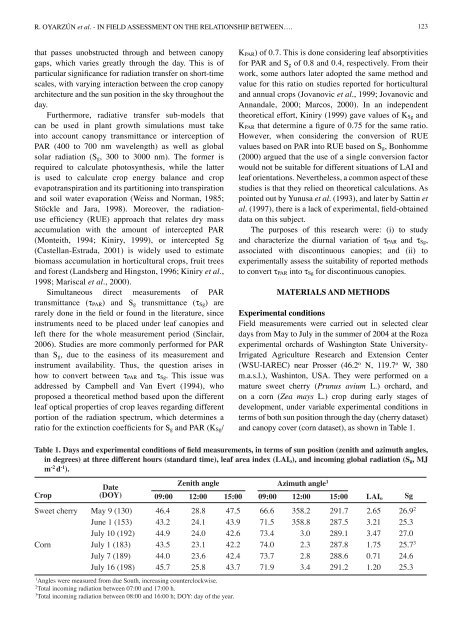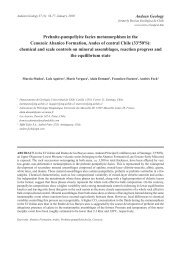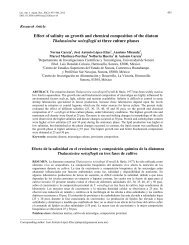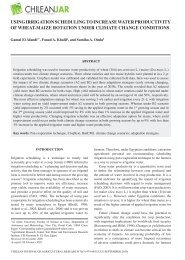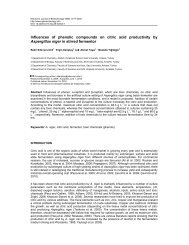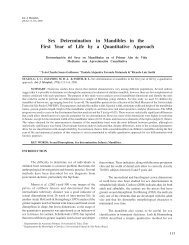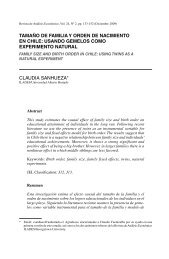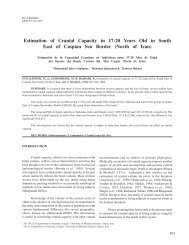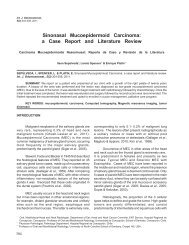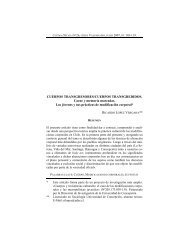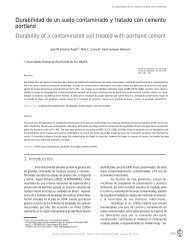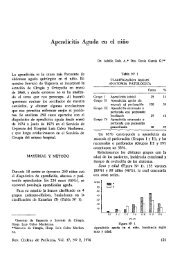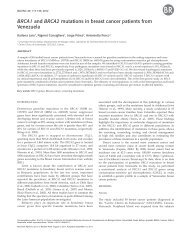(par) and global solar radiation transmittance t
(par) and global solar radiation transmittance t
(par) and global solar radiation transmittance t
You also want an ePaper? Increase the reach of your titles
YUMPU automatically turns print PDFs into web optimized ePapers that Google loves.
R. OYARZÚN et al. - IN FIELD ASSESSMENT ON THE RELATIONSHIP BETWEEN….<br />
123<br />
that passes unobstructed through <strong>and</strong> between canopy<br />
gaps, which varies greatly through the day. This is of<br />
<strong>par</strong>ticular significance for <strong>radiation</strong> transfer on short-time<br />
scales, with varying interaction between the crop canopy<br />
architecture <strong>and</strong> the sun position in the sky throughout the<br />
day.<br />
Furthermore, radiative transfer sub-models that<br />
can be used in plant growth simulations must take<br />
into account canopy <strong>transmittance</strong> or interception of<br />
PAR (400 to 700 nm wavelength) as well as <strong>global</strong><br />
<strong>solar</strong> <strong>radiation</strong> (S g, 300 to 3000 nm). The former is<br />
required to calculate photosynthesis, while the latter<br />
is used to calculate crop energy balance <strong>and</strong> crop<br />
evapotranspiration <strong>and</strong> its <strong>par</strong>titioning into transpiration<br />
<strong>and</strong> soil water evaporation (Weiss <strong>and</strong> Norman, 1985;<br />
Stöckle <strong>and</strong> Jara, 1998). Moreover, the <strong>radiation</strong>use<br />
efficiency (RUE) approach that relates dry mass<br />
accumulation with the amount of intercepted PAR<br />
(Monteith, 1994; Kiniry, 1999), or intercepted Sg<br />
(Castellan-Estrada, 2001) is widely used to estimate<br />
biomass accumulation in horticultural crops, fruit trees<br />
<strong>and</strong> forest (L<strong>and</strong>sberg <strong>and</strong> Hingston, 1996; Kiniry et al.,<br />
1998; Mariscal et al., 2000).<br />
Simultaneous direct measurements of PAR<br />
<strong>transmittance</strong> (τ PAR) <strong>and</strong> S g <strong>transmittance</strong> (τ Sg) are<br />
rarely done in the field or found in the literature, since<br />
instruments need to be placed under leaf canopies <strong>and</strong><br />
left there for the whole measurement period (Sinclair,<br />
2006). Studies are more commonly performed for PAR<br />
than S g, due to the easiness of its measurement <strong>and</strong><br />
instrument availability. Thus, the question arises in<br />
how to convert between τ PAR <strong>and</strong> τ Sg. This issue was<br />
addressed by Campbell <strong>and</strong> Van Evert (1994), who<br />
proposed a theoretical method based upon the different<br />
leaf optical properties of crop leaves regarding different<br />
portion of the <strong>radiation</strong> spectrum, which determines a<br />
ratio for the extinction coefficients for S g <strong>and</strong> PAR (K Sg/<br />
K PAR) of 0.7. This is done considering leaf absorptivities<br />
for PAR <strong>and</strong> S g of 0.8 <strong>and</strong> 0.4, respectively. From their<br />
work, some authors later adopted the same method <strong>and</strong><br />
value for this ratio on studies reported for horticultural<br />
<strong>and</strong> annual crops (Jovanovic et al., 1999; Jovanovic <strong>and</strong><br />
Ann<strong>and</strong>ale, 2000; Marcos, 2000). In an independent<br />
theoretical effort, Kiniry (1999) gave values of K Sg <strong>and</strong><br />
K PAR that determine a figure of 0.75 for the same ratio.<br />
However, when considering the conversion of RUE<br />
values based on PAR into RUE based on S g, Bonhomme<br />
(2000) argued that the use of a single conversion factor<br />
would not be suitable for different situations of LAI <strong>and</strong><br />
leaf orientations. Nevertheless, a common aspect of these<br />
studies is that they relied on theoretical calculations. As<br />
pointed out by Yunusa et al. (1993), <strong>and</strong> later by Sattin et<br />
al. (1997), there is a lack of experimental, field-obtained<br />
data on this subject.<br />
The purposes of this research were: (i) to study<br />
<strong>and</strong> characterize the diurnal variation of τ PAR <strong>and</strong> τ Sg,<br />
associated with discontinuous canopies; <strong>and</strong> (ii) to<br />
experimentally assess the suitability of reported methods<br />
to convert τ PAR into τ Sg for discontinuous canopies.<br />
MATERIALS AND METHODS<br />
Experimental conditions<br />
Field measurements were carried out in selected clear<br />
days from May to July in the summer of 2004 at the Roza<br />
experimental orchards of Washington State University-<br />
Irrigated Agriculture Research <strong>and</strong> Extension Center<br />
(WSU-IAREC) near Prosser (46.2 o N, 119.7 o W, 380<br />
m.a.s.l.), Washinton, USA. They were performed on a<br />
mature sweet cherry (Prunus avium L.) orchard, <strong>and</strong><br />
on a corn (Zea mays L.) crop during early stages of<br />
development, under variable experimental conditions in<br />
terms of both sun position through the day (cherry dataset)<br />
<strong>and</strong> canopy cover (corn dataset), as shown in Table 1.<br />
Table 1. Days <strong>and</strong> experimental conditions of field measurements, in terms of sun position (zenith <strong>and</strong> azimuth angles,<br />
in degrees) at three different hours (st<strong>and</strong>ard time), leaf area index (LAI o), <strong>and</strong> incoming <strong>global</strong> <strong>radiation</strong> (S g, MJ<br />
m -2 d -1 ).<br />
Date<br />
Zenith angle Azimuth angle 1<br />
Crop (DOY) 09:00 12:00 15:00 09:00 12:00 15:00 LAI o Sg<br />
Sweet cherry May 9 (130) 46.4 28.8 47.5 66.6 358.2 291.7 2.65 26.9 2<br />
June 1 (153) 43.2 24.1 43.9 71.5 358.8 287.5 3.21 25.3<br />
July 10 (192) 44.9 24.0 42.6 73.4 3.0 289.1 3.47 27.0<br />
Corn July 1 (183) 43.5 23.1 42.2 74.0 2.3 287.8 1.75 25.7 3<br />
July 7 (189) 44.0 23.6 42.4 73.7 2.8 288.6 0.71 24.6<br />
July 16 (198) 45.7 25.8 43.7 71.9 3.4 291.2 1.20 25.3<br />
1<br />
Angles were measured from due South, increasing counterclockwise.<br />
2<br />
Total incoming <strong>radiation</strong> between 07:00 <strong>and</strong> 17:00 h.<br />
3<br />
Total incoming <strong>radiation</strong> between 08:00 <strong>and</strong> 16:00 h; DOY: day of the year.


